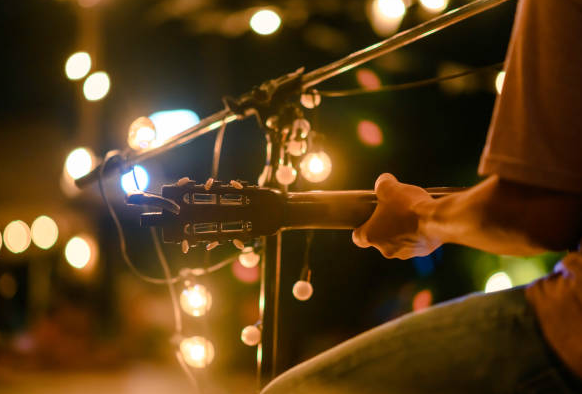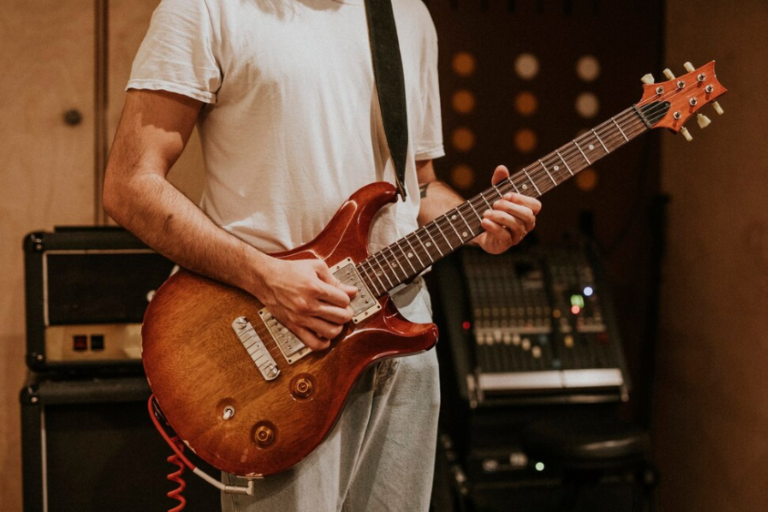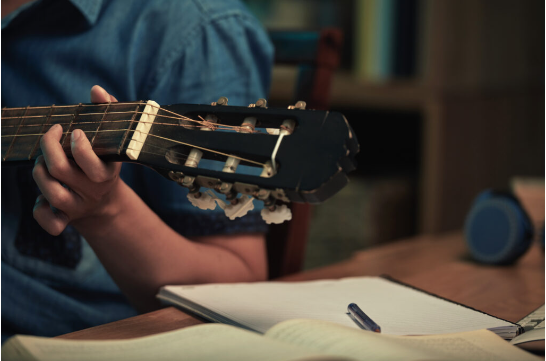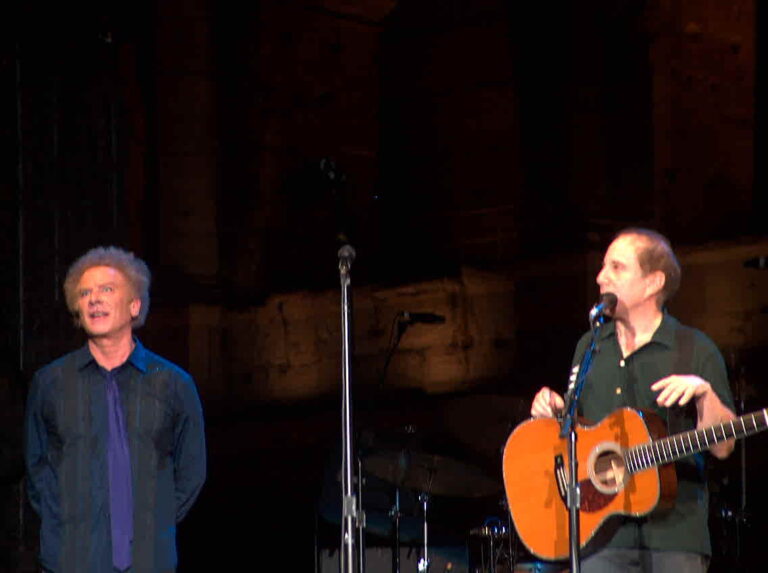A Guide With Everything You Need To Play Barre Chords
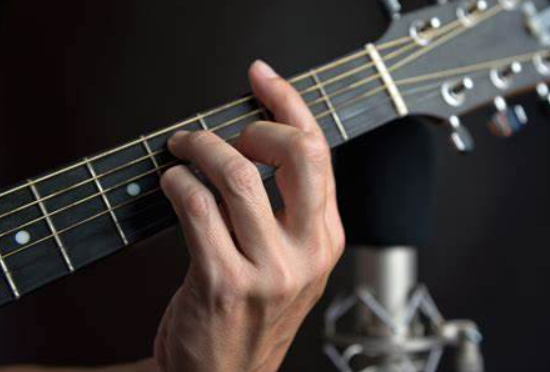
Pardon my excitement but, Barre Chords. Rock on DUDE. You see, barre chords are the alpha wolf in the guitar-playing wilderness! They’re the cogs that transform a good guitarist into a rocking guitarist. These mighty chords are like the secret sauce to your spicy guitar routine and are featured on all the songs you love and rock to.
The magic of barre chords began to unfold in the music world from the 1960s. They were prominently used by iconic guitarists like Jimi Hendrix and Eric Clapton, defining genres like Blues and Rock. Imagine the electrifying power of those barre chords, vibrating through the air, and piercing the hearts of the listeners!
Here’s a tip: barre chords are like dominos that you’ve got to balance carefully. You use your index finger as the backbone, your third finger stretches a bit. It’s like playing a balancing act with your fingers!
1. History and Background of Barre Chords
The history of barre chords is deeply intertwined with the evolution of guitar playing, tracing back to the early days when the guitar began to find its voice in the world of music. Initially, the guitar was primarily used for rhythm and classical pieces. However, as musical styles evolved, so did the techniques used in guitar playing.
Origins and Early Use
Barre chords likely originated from the need for guitarists to expand the range of chords they could play. In classical music, where the guitar had more of a solo voice, the ability to play a wider range of chords was essential. The technique of using one finger to hold down multiple strings at the same fret allowed for more complex compositions and was a stepping stone in the guitar’s evolution from a rhythm-based to a lead instrument.
Rise in Jazz and Blues
The real breakthrough for barre chords came with the advent of jazz and blues. These genres demanded a level of harmonic sophistication and flexibility that open chords alone couldn’t provide. Jazz guitarists, in particular, found barre chords invaluable for playing through the complex chord progressions and key changes characteristic of the genre.
Rock and Roll Era
The golden age of rock and roll saw barre chords come into their own. Guitarists like Jimi Hendrix and Eric Clapton used barre chords not just for their harmonic possibilities but as a tool for expression. Hendrix, for instance, was known for his innovative use of the thumb-over technique to play barre chords, allowing him to incorporate melodic lines and embellishments easily.
Impact on Guitar Design
The popularity of barre chords even influenced guitar design. Electric guitars, with their slimmer necks and lower string action, made it easier to play barre chords, thus becoming a favorite among rock and jazz musicians. This shift in guitar design opened up new avenues for sonic exploration and performance.
Cultural Significance
Beyond just a technical aspect of guitar playing, barre chords played a significant role in the cultural impact of the music they were a part of. In rock music, they contributed to the powerful and aggressive sound that defined the rebellious spirit of the genre. In jazz, they facilitated the complex and sophisticated harmonies that made the genre so revolutionary.
Modern Usage
Today, barre chords remain a fundamental part of guitar playing across various genres. They are essential for guitarists looking to explore beyond basic chord shapes and delve into more advanced musical territories. The versatility and full sound that barre chords provide continue to make them a staple in the guitarist’s toolkit.
2. The Basics of Barre Chords: How to Finger Them
Barre chords are a fundamental aspect of guitar playing, allowing you to play a wider range of chords using the same shape across different frets. Here’s a step-by-step guide on how to finger major and minor barre chords, the two main types:
Fingering Major Barre Chords
Let’s start with a major barre chord based on the E major shape:
Choose the Root Note- For this example, let’s play a G major barre chord. The root note of this chord is G, which is located on the 3rd fret of the low E string.
Barre the Fret- Place your index finger flat across all six strings at the 3rd fret. This is your barre. Ensure your finger is close to the fret without being on top of it.
Position Other Fingers:
- Place your ring finger on the 5th fret of the A string.
- Place your pinky finger right below it on the 5th fret of the D string.
- Place your middle finger on the 4th fret of the G string.
Strum All Strings- Strum all the strings, making sure each note rings clearly. If any string sounds muted or buzzy, adjust your finger positioning, ensuring the barre is firm and the other fingers are arched properly.
Fingering Minor Barre Chords
Now, let’s try a minor barre chord based on the E minor shape:
Choose the Root Note- For a minor barre chord, let’s pick A minor. The root note A is on the 5th fret of the low E string.
Barre the Fret- As before, barre all six strings at the 5th fret with your index finger.
Position Other Fingers:
- Place your ring finger on the 7th fret of the A string.
- Place your pinky finger on the 7th fret of the D string.
- The G, B, and high E strings will be barred by your index finger at the 5th fret.
Strum All Strings- Strum all strings and check for clear ringing notes. Adjust your fingers as needed for clarity.
Tips for Effective Barre Chords
- Finger Position: Your index finger should be straight and parallel to the frets. Use the side of your finger where the bone is closest to the skin for a firmer barre.
- Thumb Placement: Your thumb should be at the back of the guitar neck, opposite your index finger, to provide leverage.
- Pressure and Comfort: Apply enough pressure to get clear sounds but avoid straining your hand. It’s normal for it to feel challenging at first, but with practice, it becomes easier.
- Practice: Start with short practice sessions to build up strength and endurance in your hand and fingers.
3. Common Barre Chord Shapes
The most common barre chord shapes are based on the open E major/minor and A major/minor chords. By moving these shapes up and down the fretboard, you can play chords in different keys. For example, an E major shape barre chord at the first fret becomes an F major chord.
4. Transitioning to Barre Chords
Transitioning from open chords to barre chords can be challenging due to the need for finger strength and flexibility. Start with simple exercises to build up your finger strength, and practice transitioning between open chords and barre chords.
5. Practice Techniques
Effective practice techniques include:
- Repeatedly forming and releasing the barre chord shape.
- Practicing chord progressions using barre chords.
- Incorporating a metronome to improve timing and consistency.
6. Advanced Barre Chord Techniques
As you become more comfortable with basic barre chords, explore more complex variations like 7th chords, suspended chords, and add9 chords. These add depth and complexity to your playing.
7. Incorporating Barre Chords into Songs
Start by choosing songs with simple barre chord progressions. Practice these songs to understand how barre chords can change the dynamics and tone of music. Experiment with different strumming patterns and rhythms.
Allow me to paint a picture of the common Barre Chord shapes for you: E major, E minor, A major, and A minor. You can slide them up and down the fretboard like dancers gliding on ice, creating different chords at each fret.
Transitioning to barre chords might feel like you’re learning to walk again, but trust me, it’s worth it. You’ll face challenges like building finger strength and adjusting hand positioning, but overcoming these hurdles is a testament to your passion.
Want to master barre chords? Adopt a “practice makes perfect” mindset. Regular drills and exercises are your best friends. Patience? It’s not just a virtue, it’s a necessity! Be prepared to have your patience tried and tested.
And don’t stop at the basics; explore more complex barre chord variations like 7th chords and suspended chords. It’s like adding more colors to your musical palette. They can dramatically enhance your playing, making your performance sound more mature and melodious.
The best part about barre chords is integrating them into songs. They can add depth to your music, creating a rich tapestry of sound that echoes with your personal style. Just listen to “Under the Bridge” by Red Hot Chili Peppers or “Tears in Heaven” by Eric Clapton.
